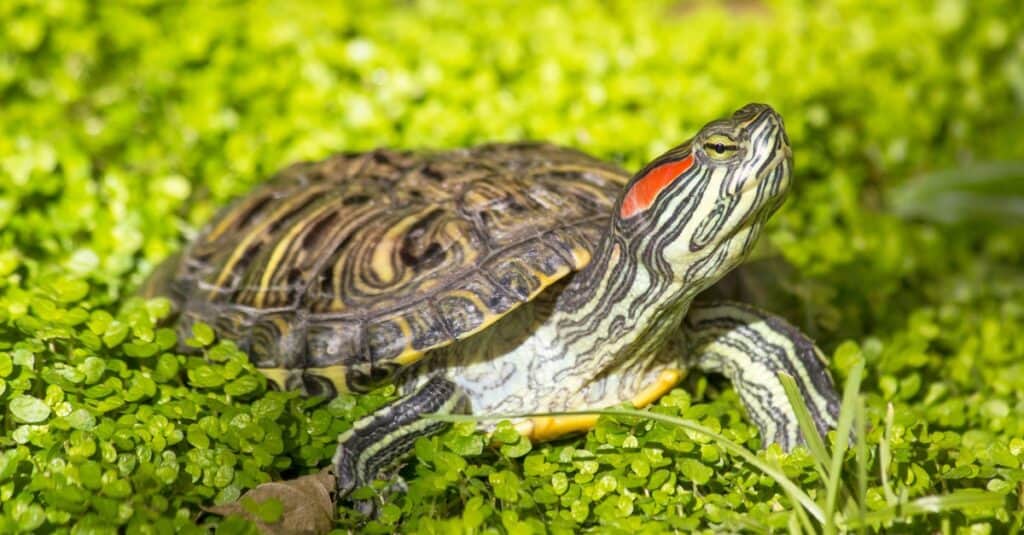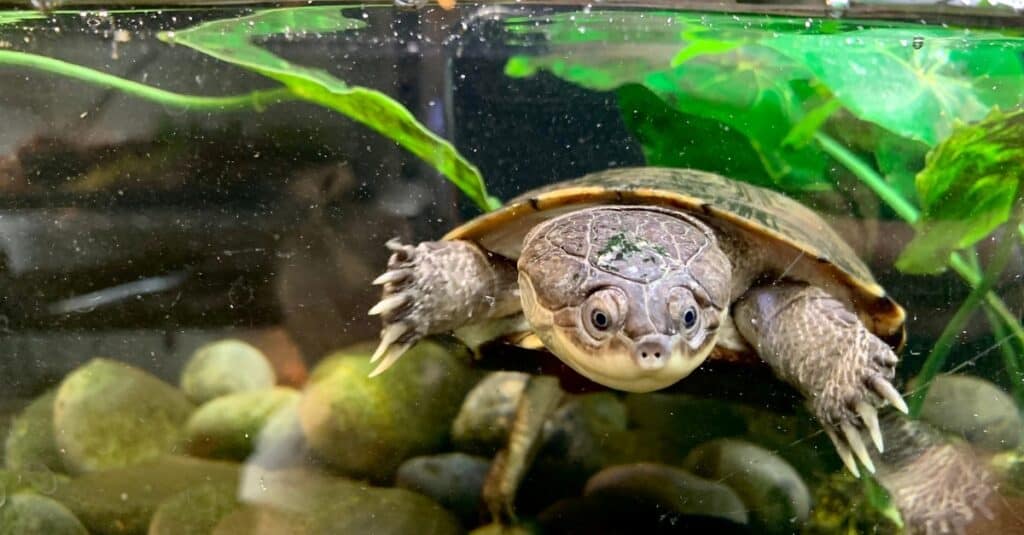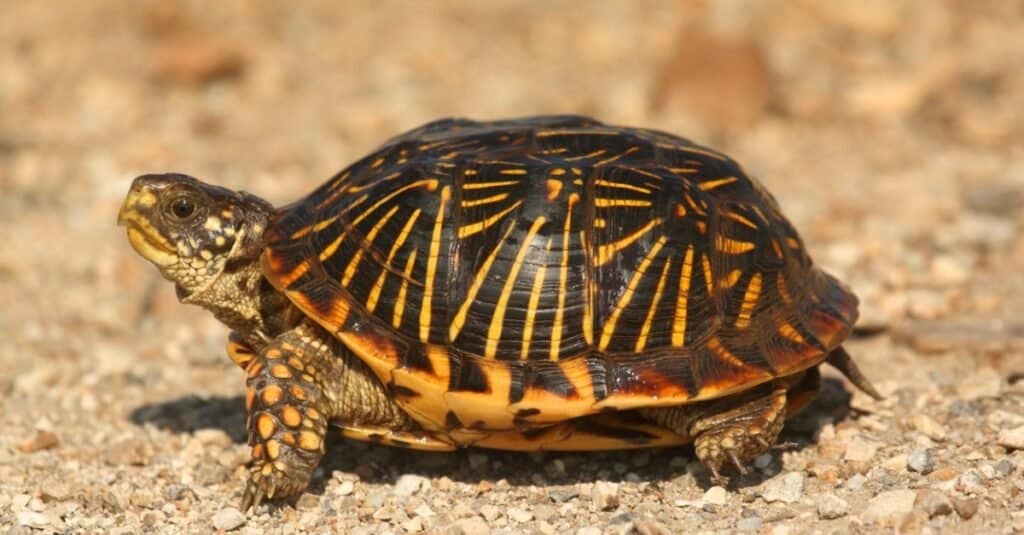Have you ever stopped to watch all of the natural activity happening around a pond? A large pond in someone’s backyard or even a small fish pond just off a home’s patio can be a home to many types of animals. Fish, frogs, and ducks are just a few examples. But no pond environment is complete without a gathering of freshwater turtles.
Pond turtles are not only interesting to observe, but they also consume insects and other pests that tend to inhabit a pond environment. Fortunately, the varied types of pond turtles make it easy to find the perfect specimens to occupy a backyard pond.
Turtles are shy and their main defense is to dive into deep water or under a submerged log to hide from predators. While they are slow on the ground, they have extremely sharp eyesight and can move very fast in the water. If you are lucky enough to see one sunning on a log, they will dive off into the water as soon as they catch a glimpse of movement. The best way to observe turtles is from a distance where you can watch them sunning.
With the exception of one, the pond turtles on this list have webbed feet and spend most of their time in the water. Some live in rivers, lakes, and streams while others have a swamp or marsh habitat. Check out some facts regarding nine of the most well-known types of pond turtles.
#9 Northern Map Turtle

©RLS Photo/Shutterstock.com
A northern map turtle gets its name from the design on its shell. Its shell can be light or dark green with a pattern of yellow lines that make it look like a map. When going about the identification of this turtle, remember that females are larger than males. The length of a female’s shell is 10.5 inches whereas a male’s shell is 6.5 inches in length. The northern map turtle is the most widely seen out of all the map turtle species.
The range of the northern map turtle goes from Quebec Canada down through the United States to Alabama. Specifically, their habitat includes rivers, large ponds, freshwater lakes, and streams. These aquatic turtles spend most of the day in the water. But they do come out to bask in the warm sunlight for a few hours in order to maintain their body temperature. Their diet includes crayfish, snails, and other small aquatic creatures.
#8 Yellow-Bellied Slider

©iStock.com/jrubacha
Identification of a yellow-bellied slider turtle is fairly easy. This freshwater turtle has a brown or green shell with yellow on its underside. It also has a slash of yellow on the side of its head. This turtle’s shell can measure from five to 11 inches long. In terms of diet, these reptiles eat insects, tadpoles, minnows, and some types of vegetation.
Yellow-bellied turtles are found in the southeastern part of the United States and down into Central America. They live in a swamp, river, pond, or lake habitat. One of the most notable facts about this turtle is it looks for a watery habitat with plenty of floating vegetation, sticks, and debris where it can hide. It is rarely out of the water for very long.
#7 European Pond Terrapin

©iStock.com/Thorsten Spoerlein
Terrapin is another name for a freshwater turtle. The European Pond terrapin has a shell measuring eight to 12 inches long. Its shell can be either brown or olive in color featuring tiny yellow spots. Knowing that these turtles have yellow and red eyes can help with proper identification.
This turtle or terrapin is found in many areas of Europe as well as in northwestern Africa and western Asia. This turtle lives in a pond or lake habitat as well as in rivers with slow-moving water. During the day, this turtle climbs onto a rock or floating log to bask in the sunlight. This turtle lives on a diet of aquatic vegetation as well as frogs and tiny fish.
#6 Red-Eared Slider

©xbrchx/Shutterstock.com
The red-eared slider has a slash of red on each side of its head. These spots of red are in the same area where the turtle’s tympanum or non-visible ears are located. Female red-eared sliders have a shell measuring 10 to 12 inches while a male has a shell seven to nine inches long. This aquatic turtle’s shell is greenish-yellow in color.
The diet of this animal is omnivorous. They eat algae, insects, worms, and snails. They are found in the southeastern United States in the Mississippi Valley. The most common habitat of this turtle is a swamp. They live in marshes, streams, and other bodies of calm, slow-moving water.
#5 African Aquatic Side-Neck Turtle

©Megan Czarnocki/Shutterstock.com
An African aquatic side-neck turtle has a longer neck than most other types of turtles. This brings up two of the most amazing facts about this creature. For one, its neck is so long it doesn’t fit all the way into its shell. So, the turtle has to move its head to the side and tuck it under the ridge of its shell instead of pulling it inside. Secondly, you probably know when a turtle is turned over onto its shell, it has a tough time getting back up onto its four feet. Amazingly, an African aquatic side-neck turtle can use its long neck to right itself again if it’s turned upside down onto its greenish-brown shell. Its shell tends to be flat and measures between seven and 12 inches long.
These aquatic turtles are found in the eastern part of Africa. They live in a stream or creek habitat. The diet of this turtle includes fish, vegetation, and insects.
#4 Box Turtle

ter.
©iStock.com/SteveByland
The box turtle is probably the most recognizable turtle on this list. This is because they’re found in many areas across the United States. Technically a cousin of the pond turtle, its curved shell is one of the most notable things about this turtle due to its yellow splotchy design over a black background. It measures between four and eight inches long. The box turtle is smaller in size than many other types of turtles weighing just one to two pounds.
Unlike the other turtles on this list, box turtles are not aquatic and they don’t have webbed feet. In fact, they live in a woodland or grassland habitat. However, this reptile still belongs on a list featuring the different types of pond turtles. This is because box turtles live near creeks, streams, and other bodies of water. They need access to water in order to drink and capture prey. It’s not unusual for a pet box turtle kept in a terrarium to climb into a shallow dish of water to sit. However, this turtle doesn’t swim and won’t go into deep water. The diet of a box turtle includes mosquitoes, crickets, worms, and other insects.
#3 Common Musk Turtle

©Ryan M. Bolton/Shutterstock.com
One of the most interesting facts about the common musk turtle relates to the way it defends itself from predators. This turtle can release a stinky odor from musk glands as a way to discourage predators from attacking it. Predators like raccoons and foxes are going to move away once they detect the musky scent. This natural defensive tactic has earned this turtle the nickname stinkpot.
Common musk turtles live across the United States. They are commonly found in a marsh or bog habitat. These turtles survive on a diet of small frogs, crayfish, and worms.
#2 Snapping Turtle

©Patrick Rolands/Shutterstock.com
One of the most well-known facts about the snapping turtle is it has a powerful bite. They are also larger in size than many of the turtles on this list. Snapping turtles can weigh up to 45 pounds. Their grayish/brown shell is eight to 14 inches long. The beaklike shape of this turtle’s mouth makes identification of this reptile fairly easy. In other words, it would be impossible to mistake a box turtle for a snapping turtle!
Snapping turtles are found in Canada as well as in the midwestern and eastern parts of the United States. They are aquatic turtles living in ponds, creeks, and lakes. In order to capture their daily diet of fish, these turtles partially bury themselves in the mud and snap at prey moving by. Another of the most surprising facts about this turtle is it can move very fast both on land and in the water.
#1 Painted Turtle

A painted turtle sitting on a log in a stream. These pond turtles are found across the United States and in Mexico.
©KARI K/Shutterstock.com
The red and yellow markings on this turtle’s green shell and body have earned it the name painted turtle. This reptile is smaller in size than many other types of pond turtles. Its shell is just five to seven inches long. In terms of identification, painted turtles are similar in appearance to red-eared sliders. But, painted turtles don’t have the red splash of color on their head that red-eared turtles possess.
These turtles are found across the United States and in Mexico. They live in a marsh, lake, creek, or pond habitat. Like many other types of pond turtles on this list, painted turtles look for a body of water with plenty of rocks, logs, and other debris where they can safely bask in the sunlight. Their diet includes insects, crayfish, and tadpoles.
Summary of 9 Types of Pond Turtles
| Species | Range | |
|---|---|---|
| 1. | Painted Turtle | Across the United States |
| 2. | Snapping Turtle | Parts of midwestern and Eastern U.S. and Canada |
| 3. | Common Musk Turtle | Across the United States |
| 4. | Box Turtle | Across United States |
| 5. | African Aquatic Side-Neck Turtle | East Africa |
| 6. | Red-Eared Slider | Mississippi Valley of U.S. |
| 7. | European Pond Terrapin | Parts of Europe, northwestern Africa, and western Asia |
| 8. | Yellow-Bellied Slider | From the southeastern United States down into Central America |
| 9. | Northern Map Turtle | From Quebec Canada down through the United States to Alabama |
The photo featured at the top of this post is © dawi88888/Shutterstock.com
Thank you for reading! Have some feedback for us? Contact the AZ Animals editorial team.






